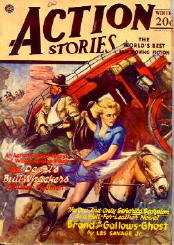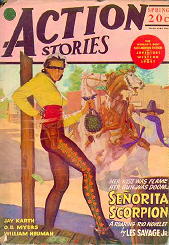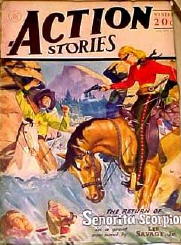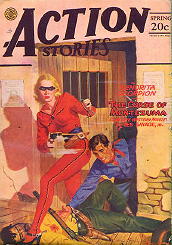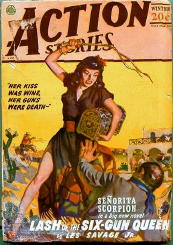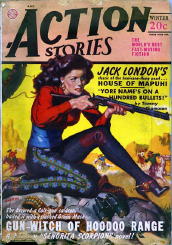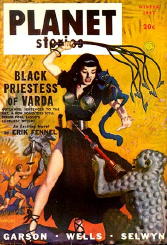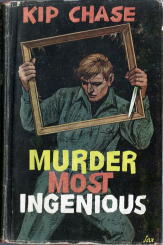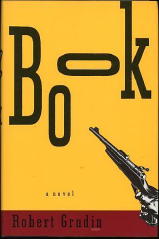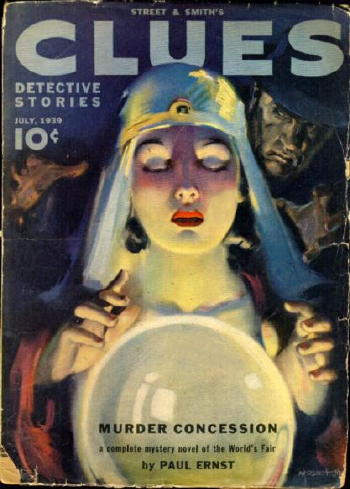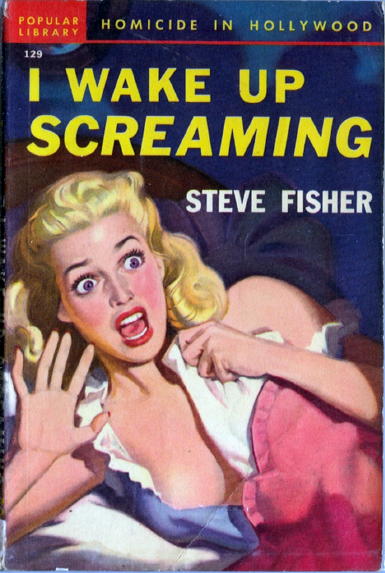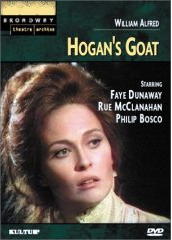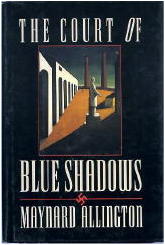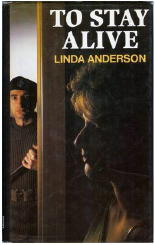February 2008
Monthly Archive
Fri 8 Feb 2008
FIRST YOU READ, THEN YOU WRITE
by Francis M. Nevins
More than seventy years ago the English writer Peter Cheyney, who knew the U.S. about as well as a toad knows existentialism, launched a series of thrillers starring two-fisted FBI agent Lemmy Caution, whose first-person narrative in Cheyney’s version of American English is of a unique eyeball-popping awfulness.
At least I thought it was unique until I stumbled upon Michael C. Peacock’s “Bait” (Clues, May 10, 1931) and its protagonist Whisper Timkins, a good-hearted pickpocket who narrates not only in first person present tense like a Damon Runyon street character but also in dialect like a Harry Stephen Keeler ethnic. “I lowers me hands and flops back onta the chair. Everythin’ is as plain as me Aunt Maggie’s face.” He also uses nouns for verbs and all sorts of other silly said substitutes as if, as he might have put it, there wuz no tomorrah.
“Rule me out,” I lips.
“You’re ruled in…,” he menaces.
“This way,” chills a icy voice.
“As for you, Garvin,” he threats.
“Now use your ears!” he grits….
“Mr. Wade,” Hope yodels, fondlin’ the gat, “have you ever been to Coney Island?”
He…oaths, “We’re leaving for there right away!”
“Terrible,” I throats, mournful.
“Sorta mixed up,” I warbles.
More than half a century after the tale got published for the first and only time, I met the author, a Canadian who had lived in the States only a few years before perpetrating this collage of howlers. I got to like him and he’s dead now so I’ll leave his real name unmentioned. No, he didn’t become a professional mystery writer.
Last month I discovered the finest film music I’ve heard in many a year. The Philip Glass score for THE ILLUSIONIST is full of the hypnotic repetitions that are the Glass trademark but it’s also hauntingly evocative of my beloved Bernard Herrmann. If you love Herrmann’s score for Hitchcock’s VERTIGO, you’ll love this one too, and probably play the CD again and again as I’ve been doing. [The link will lead to a trailer for the film. —Steve.]

In our Poetry Corner this month is THE LEAGUE OF FRIGHTENED MEN (1935), the second of Rex Stout’s Nero Wolfe novels. Wolfe’s adversary in this one is Paul Chapin, who was crippled and apparently emasculated in a fraternity hazing incident at Harvard in 1909 that went horribly wrong. A quarter century later Chapin has attained something of a literary reputation. As members of the group that maimed him begin dying off, the survivors receive anonymous poems that send them scurrying to Wolfe in fright. The first, following the apparently accidental death of a judge in a fall over a cliff, begins:
Ye should have killed me, watched the last mean sigh
Sneak through my nostril like a fugitive slave
Slinking from bondage.
Ye should have killed me.
Ye killed the man,
Ye should have killed me!
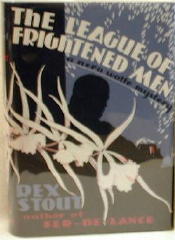
Wolfe, who admits that he “cannot qualify as an expert in prosody” but claims to be “not without an ear,” calls the poem “verbose, bombastic, and decidedly spotty.” Suspecting that a few lines were influenced by Edmund Spenser, he has Archie Goodwin pull down the collected works of that poet: “dark blue, tooled…. A fine example of bookmaking… Printed of course in London, but bound in this city by a Swedish boy who will probably starve to death during the coming winter.” The hunt for parallel passages fails but in any event, says Wolfe, “it was pleasant to meet Spenser again, even for so brief a nod.” The second death, the apparent poison suicide of an art dealer, triggers a second poem:
Two.
Ye should have killed me.
Two;
And with no ready cliff, rocks waiting below
To rub the soul out;…
I found the time, the safe way to his throat….
Ye should have killed me.
Then comes the mysterious vanishing of a Columbia psychology professor and yet another effusion:
One. Two. Three.
Ye cannot see what I see;
His bloody head, his misery, his eyes….
One. Two. Three.
We occasionally find Wolfe savoring a volume of poetry but in none of the full-length or short novels is poetry as central as in this longest and perhaps finest exploit of the obese and infuriating genius of West Thirty-Fifth Street.
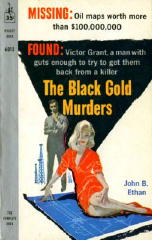
Of all the silly lines in mystery fiction, one in particular has clung like a barnacle to the underside of my memory for more decades than I care to count. It’s in THE BLACK GOLD MURDERS (1959), a long-forgotten novel by a long-forgotten author — John B. Ethan, if you must know — in which a woman introducing the narrator to two beatniks says: “The one on the right thinks he’s Zen Buddha.” You remember Zen from World Religions 101, right? Wasn’t he Prince Gautama’s kid brother?
Fri 8 Feb 2008
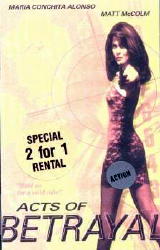
ACTS OF BETRAYAL. 1997, Conquistador Entertainment. Maria Conchita Alonso, Matt McColm, Muse Watson, David Groh, Susan Lee Hoffman. Director: Jack Ersgard.
If you were to ask, I’d say that as a rough guess maybe 80% of this 90 minute action film is exactly that: non-stop action. There are more bullets flying in this picture than in many small revolutions, and at the end there are only two people left standing: star corruption witness Eva Ramirez (Maria Conchita Alonso) and stalwart, straight-as-an arrow FBI agent Lance Cooper (Matt McColm), whose thankless job it is to get her before the investigating jury.
Opposing them is a veritable army of thugs, soldiers of fortune, outlaws, bikers and miscellaneous gunmen, organized and fortified by two individuals (one man with a tall, strikingly beautiful female assistant) in a well-equipped communications van, complete with state-of-the-art computers and backup plans and mercenary forces far beyond anything Al Capone ever dreamed of.
Did I say that agent Cooper is straight-laced? What I didn’t say is that the lady he is escorting is uninhibited, a non-stop talker, an incessant chatterer, often suggestively and R-rated, and of course, as they most often do, opposites attract. Eventually. I love it. And of course they save each others’ lives more than once.
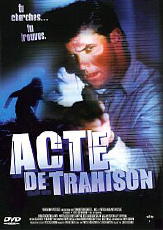
For the kind of movie this is, on a scale of one to five, I would give this one a five. The acting is far above average, the dialogue witty, and while realism has no basis in the story line, realism is not exactly what people who watch movies like this are watching for.
For the kind of movie this also is, there is no scale from one to ten. I do concede that movies like this do not deserve a scale that goes that high.
I’ve not been able to find this movie on DVD in English — only in Spanish, or as a beat-up former video rental. I guess you’ve have to explain the economics of movie-making to me. I’m sure this never played in theaters, only on cable. Even a cheap five dollar DVD would recoup some of the production costs, wouldn’t it?
Thu 7 Feb 2008
After my
recent review of Les Savage’s collection of western stories
THE SHADOW IN RENEGADE BASIN, Keith Chapman left a comment about Señorita Scorpion, the aptly named blonde heroine who appeared in one of them. As part of my reply to him, I thought I’d work up a checklist of all of the stories that she was ever in.
This turned out to be a lot more difficult than I’d planned. There may already be such a list, but if so, I couldn’t find one on the Internet. Without a collection of the magazines themselves, and rather than struggle more than I needed to, I went to the source himself, Jon Tuska, who’s been busily editing and packaging Les Savage’s work to various publishers over the years. Here’s his reply:
Dear Steve
There were originally seven Señorita Scorpion stories. The first three were first collected in THE LEGEND OF SEÑORITA SCORPION (Circle V Westerns, 1996). The fourth story was collected in THE RETURN OF SEÑORITA SCORPION (Circle V Westerns, 1997). The sixth story was collected in THE LASH OF SEÑORITA SCORPION (Circle V Westerns, 1998). These were large print editions.
Only the first collection of three stories appeared in a standard print hardcover: THE LEGEND OF SEÑORITA SCORPION (Gunsmoke, 2003) published in the Gunsmoke series distributed worldwide by BBC Audiobooks Ltd. The reason we stopped the stories from appearing in this Circle V Western series is that they began to appear in Les Savage, Jr., trios published in the Five Star Westerns. They now have all appeared in such Five Star trios.
Here are the seven stories in terms of first restored appearances in the Five Star Westerns:
“Brand of the Gallows-Ghost” by Les Savage, Jr. in Action Stories (Winter, 45) was originally titled by the author “The Brand of Penasco” and was collected under this title in THE SHADOW IN RENEGADE BASIN (Five Star Westerns, 2000).
“The Sting of Señorita Scorpion” by Les Savage, Jr. in Action Stories (Winter, 49) was originally titled by the author “Scorpion’s Return” but was collected under its magazine title in THE STING OF SEÑORITA SCORPION (Five Star Westerns, 2000).
“Señorita Scorpion” by Les Savage, Jr. in Action Stories (Spring, 44) was originally titled by the author “Death ’Rods the Big Thicket Bunch” but was collected under its magazine title in THE DEVIL’S CORRAL (Five Star Westerns, 2003).
“The Brand of Señorita Scopion” by Les Savage, Jr. in Action Stories (Summer, 44) was originally titled by the author “Señorita Six-Gun” but was collected under its magazine title in THE BEAST IN CAÑADA DIABLO (Five Star Westerns, 2004).
“Secret of Santiago” by Les Savage, Jr. in Action Stories (Winter, 44) was originally titled by the author “Secret of the Santiago” and was collected under this title in TRAIL OF THE SILVER SADDLE (Five Star Westerns, 2005).
“The Curse of Montezuma” by Les Savage, Jr. in Action Stories (Spring, 45) was originally titled by the author “Six-Gun Serpent God” but was collected under its magazine title in THE CURSE OF MONTEZUMA (Five Star Westerns, 2006).
“Lash of the Six-Gun Queen” by Les Savage, Jr. in Action Stories (Winter, 47) was originally titled by the author “The Return of Señorita Scorpion” but was collected under the title “The Lash of Señorita Scorpion” in WOLVES OF THE SUNDOWN TRAIL (Five Star Westerns, 2007).
There is a lot of background on each story in the head notes in these various collections. Savage was not as fond of these stories as was Malcolm Reiss at Fiction House, and hence his writing of them was somewhat sporadic. Although he expanded several of his short novels for magazines into book-length novels, he never went back to do so with any of these stories, nor did he try to weld them together into collections the way we have done.
NOTE: These cover images came from Phil Stephensen-Payne’s mammoth Galactic Central website, a source that every Fiction Magazine collector should absolutely know about.
[UPDATE] 02-08-07. Turns out that someone has done a list, as I suspected, even though I still haven’t seen it. And not only that, but there’s a story missing in Jon’s list above, but that’s because Les Savage didn’t write it.
After posting a link to this blog entry on the Yahoo PulpMags group, Will Murray vaguely remembered that maybe Emmett McDowell did a Señorita Scorpion story. This rang a bell with me, too. Then Brian Earl Brown came up with the title. It’s in John DeWalt’s book Keys to Other Doors:
“Gun-Witch of Hoodoo Range,” Action Stories, Winter 1948/1949, by Emmett McDowell.
Thanks, gents!
[UPDATE #2.] 02-08-07. From long-time pulp fan Jerry Page, reprinted from the PulpMags group with his permission:
For years I read only sf and fantasy pulps — I owned some non-sf pulps and had read some hero novels, Spider, Shadow, Doc, etc., but I wasn’t all that interested in pulps outside the sf field.
Then, wondering through the dealers’ room at a convention I saw a stack of Action Stories on a table and the Winter 1947 issue caught my eye. I knew I had seen it before.
Where? On the Winter 1947 issue of Planet Stories.
Both covers were by Allen Anderson. The Planet cover illustrated Erik Finnel’s “Black Priestess of Varda.” The Action cover was the same figure of a woman holding a whip and being attacked by either an outlaw or Indian (I haven’t tried digging it out of the box its in so forgive me, but this is from memory).
Obviously done from the same reference photo of the same model in the same pose. Composition and so on the same. But one was SF and the other was Western. I bought the Action Stories, took it home and compared it with the Planet Stories and confirmed what I thought I had seen. I think I bought three Actions and in each of them there was a Senorita Scorpion story by Les Savage. I read one of them and it was pretty good. I concluded Savage might be a better than average writer. So I read the others. They weren’t quite as good as the first one, but they were good.
And that’s how I started reading pulps outside the SF field. I still think Savage is one of the better western writers. Reading him led to reading more Westerns, and I also started reading other kinds of pulps, discovering the great wealth of fiction to be found in Adventure, Black Mask and the better Air War pulps such as Wings. (Joel Townsley Rogers is one of the great pulp writers, and his best World War I stories, especially the aviation stories are close to being masterpieces.) I examined my Argosy issues I’d picked up because they contained fantastic stories, and started reading other types of fiction.
Thu 7 Feb 2008
It’s been a while since I’ve printed one of these reviews from TMF, so I’ll repeat the introductory explanation that came with the first one I did, back in last July.
These reviews will come from the long distant past, nearly 30 years ago, in fact. All were published in a fanzine published by Guy M. Townsend, and called
The MYSTERY FANcier. I’ll use the initials
TMF in the headings to so indicate where all such reviews first appeared. Prior to their
TMF publication, some of the reviews were appeared in the
Hartford Courant (not a fanzine) and will also be so designated.
I’m going to reprint the reviews as they were published at the time, whatever warts I see they may have when I read them now. I will update the publishing history of the books, and on occasion, perhaps even most of the time, add Updates or other Commentary.
I no longer use letter grades to close up my reviews, but I did back then, and for better or worse, I’ll include them now. Don’t hold me too closely to either my comments or the grades I assigned to the books. I was a different person then, and so (probably) were you.
HELEN NIELSEN – After Midnight.
Curtis 07204; paperback reprint, no date stated. Hardcover edition: William Morrow, 1966; hardcover reprint: Detective Book Club [3-in-1 edition], July 1966.
When I think of defense attorneys and mystery stories, I think of Perry Mason. Sam Drake is a part-time lawyer only, and in the author’s own words, a full-time bon vivant, which is hardly promising. He does don the appropriate suit of shining armor at the proper time, however, to take up the defense of a beautiful client accused of stabbing her husband to death. But then rather than tackling the case as a personal challenge to his own flamboyant sense of justice, he takes the considerably more dangerous step of becoming more and more personally involved with the new widow.
After an emotion-packed trial in which all the unanswered questions are carefully avoided, some hops and skips in logic combine with what at first seems insurmountable coincidence to lead the solution off in perversely contrary directions. The writing is often noticeably pulpy, to match the hero, I guess. [C minus]
– From The MYSTERY FANcier, Vol. 3, No. 2, Mar-Apr 1979.
[UPDATE] 02-07-08. I have only the barest recollection of reading this book. The review you’ve just read is as new to me as it is to you. I can’t locate my copy, nor can I find a cover image online, so for once we’ll have to go without one. (If you happen to have either the paperback or the hardcover, a scan would be welcome.)
Of Helen Nielsen, born in 1918 and died 2002, Contemporary Authors says:
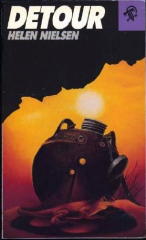
“Helen Nielsen writes mystery stories in which she carefully plays fair with the reader, providing enough information for the mystery to be solved. Nielsen mixes her detective puzzles with realistic character studies and often sets her stories in southern California, where she has lived since her childhood. Her California, however, is often the “the chilling rains or the thick, yellow, and dripping fogs of winter,” according to Mary Groff in the St. James Guide to Crime and Mystery Writers.”
Here are excerpts from reviews of some of her other books, by such critics as
Anthony Boucher: “… in a vein of quietly observant realism, underlined by sustained emotional horror.”
Jon L. Breen: “Nielsen has successfully combined the chase-adventure-espionage tale with a formal, fairly clued detective puzzle, a rarer feat than one might imagine.”
Newgate Callendar: “… a smooth piece of work . . . urbane and agreeable.”
Two of her novels were considered either hard-boiled or noirish enough for them to have been reprinted by Black Lizard. These are the two covers you’ll see somewhere here above or below.
After all of this accumulated evidence, I don’t know about you, but I’m ready to read After Midnight again, if I could, and see if I have the same opinion as I did back in 1979. I may have been wrong on this one.
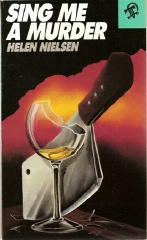
As for Steve Drake, I did not know he was a series character then, but thanks to Al Hubin and Crime Fiction IV, I do now. Here’s a list of all of the cases he handled:
After Midnight. Morrow, 1966. Setting: California.
A Killer in the Street. Morrow, 1967. Setting: Tucson, AZ.
The Darkest Hour. Morrow, 1969. Setting: California.
The Severed Key. Gollancz, UK, 1973. Setting: California.
The Brink of Murder. Gollancz, UK, 1976.
These last two books, which were also the last two she wrote, were never published in the US.
Wed 6 Feb 2008
This collection of authors came from Part 7 of the online Addenda to Al Hubin’s Crime Fiction IV. Al recently received an email from the first of these writers, Kip Chase, who lives in San Luis Obispo CA. Mr. Chase cleared up several questions about his entry in CFIV, which we’re very pleased to include here.
CHASE, KIP. Pseudonym of Trevett Coburn Chase, 1928- , q. v. Under this pen name, the author of three detective novels included in the (Revised) Crime Fiction IV. See below. SC in all three: Mr. Justine Carmichael, a retired LAPD chief of homicide, now confined to a wheelchair. (Note: That the detective’s name is Justine, rather than Justin, as intended, was a typing error which was not caught and perpetuated its way through all three books.)
Killer Be Killed. Hammond, UK, hc, 1963. Setting: Mexico
Murder Most Ingenious. Hammond, UK, hc, 1962. Add setting: California. [An impossible crime included in Locked Room Murders by Robert Adey: A wealthy estate owner is found knifed to death in his well-guarded art gallery, and a valuable Gaughin painting stolen.]
Where There’s a Will. Hammond, UK, hc, 1961. Setting: California.
CHASE, OLIVE (MAUD?). 1908-1987?. Add tentative middle name and year of birth. With either Stanley Clayton or Stewart Burke, co-author of four mystery-oriented plays published by French (UK) between 1965 and 1978. All four are included in the (Revised) Crime Fiction IV. To these add the following:
Impact, with Maureen Nield, 1935-2004, q.v. French (London), 1982. (Play.) Synopsis: “Wife kills unfaithful husband, doctor helps cast suspicion on sister-in-law.”
CHASE, TREVETT COBURN. 1928- . Add confirmed year of birth. Pseudonym: Kip Chase, q.v.
CHITTENDEN, F(RANK) A(LBERT). 1910-1998. Add year of death. Author of five crime novels published in the UK between 1947 and 1954; all are included in the (Revised) Crime Fiction IV. Of these, only one was later published in the US; see below:
Strange Welcome. T. V. Boardman, UK, hc, 1949. Coward-McCann, US, hc, 1949. Setting: England. [Shown is the cover of a German edition.]
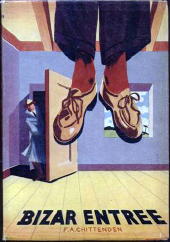
CLAPPERTON, RICHARD (GUY). 1934-1984. Add year of death. Born in Scotland; miltary service in Australia, early 1950s. Proofreader, cartoonist; author with three novels included in the (Revised) Crime Fiction IV. See below. SC: Private eye Peter Fleck appears in all three.
No News on Monday. Constable, UK, hc, 1968. Setting: Australia. US title: You’re a Long Time Dead, Putnam, 1968. [Peter Fleck is hired to find a woman but finds her dead.]
The Sentimental Kill. Constable, UK, hc, 1976. Setting: Australia. [Is famous British author Temple Wilde really missing, or has he just chosen to disappear on a sentimental journey to Australia?]
Victims Unknown. Constable, UK, hc, 1970.
_You’re a Long Time Dead. Putnam, US, hc, 1968. See: No News on Monday (Constable, 1968).
CLARK, LAURENCE (WALTER). 1914-1987. Add year of death. Born in England; journalist & free-lance writer, founder of the publishing firm Veracity Ventures Ltd., 1964. Author of one novel included in the (Revised) Crime Fiction IV. See below.
Murder of the Prime Minister. Veracity Ventures, UK, hc, 1965. Setting: England, 1812. [The assassination of President Kennedy is juxtaposed against that of Spencer Perceval 151 years earlier.]
CLAY, MICHAEL JOHN. 1934-2000. Add year of death. Pseudonym: John Griffin, q.v.
GRIFFIN, JOHN. Pseudonym of Michael John Clay, 1934-2000, q.v. Add year of death. Under this pen name, the author of 11 espionage thrillers included in the (Revised) Crime Fiction IV. All were published Robert Hale in the UK between 1976 and 1981. SC: Richard Raven, in all.
GRUDIN, ROBERT. 1938- . Ref: CA. Add as a new author entry. An educator, editor, and writer, including a study of William Shakespeare.
-Book. Random House, 1992. Setting: Academia. [A parody of scholars, literary ideologies, and the academic novel: an author of an out-of-print novel that offended other academics in its parodies of literary thinking is threatened by murder.]
NIELD, MAUREEN. 1935-2004. Add as a new author entry. Playright; co-author of the mystery drama listed below:
Impact, with Olive Chase, 1908-1987?, q.v. French (London), 1982. (Play.)
Wed 6 Feb 2008
At the tail end of a previous posting on pulp writer Carl Buchanan, aka James Robert Peery, including a long bibliography, I closed with the following:
“In addition, James Robert Peery had a letter published in the July 1939 issue of Clues, which neither Victor nor I have seen. If anyone has a copy of the magazine, we’d love to know what he had to say.”
Thanks to the assistance of pulp collector Paul Herman, I now have a copy of that issue. Not only did Peery have a letter quoted, but some of the others who write in had interesting things to say as well.
H. L. Melleney:
“I got a kick out of ‘The Drums Drone Death,’ by J. Allan Dunn, in the last issue of Clues. This fellow Dunn certainly knows his locale, and the character, John Carter, is swell. I would like to read some more John Carter yarns, with the New Hebrides background.”
Editor: “Mr. Dunn is now writing a John Carter complete novel for Clues.”
Ray Robinson:
“Your all-star authors for Clues are a splendid choice. I want to compliment you especially on J. Allan Dunn.
“His ‘The Drums Drone Death’ makes the New Hebrides really there for us. His character is alive and human. Let us have more of these interesting stories.
Editor: “Mr. Peery, whose new book is a sensation, used to be our ‘Carl Buchanan.'”
James Robert Peery:
“Heap long time I have been a reader of Clues — from ’way back when I sold the former editors an occasional short or novelette under my Carl Buchanan pseudonym. The Donald Wandrei yarn [“The Painted Nudes”] in the current issue is good. Also liked the short story [“ Murder Is a Pipe”] by [Otis Adelbert] Kline — but the best yarn in the April issue was by J. Allan Dunn. Note that you asked for reader comment on this one. I believe a John Carter series would go over in a big way. Of course, I read from the point of view of a writer — can’t quite relax and enjoy a story for admiring or criticizing technique of the author.
“I think your readers appreciate authenticity. Personally I’d like to see John Carter in action again. I get bored with these super-detectives. The change to a human, red-headed young fellow feeling his way is quite a relief. The locale should provide Dunn with plenty good ideas for plots.
“You’re doing a swell job of editing. Keep up the good work!”
Sincerely yours,
James Robert Peery
Eupora, Mississippi
Unfortunately, in spite of this groundswell of support from readers for another story about John Carter, about whom I know nothing more than this, it never happened. I could have missed it in my search through the Cook index, true, but “The Drums Drone Death” appears to have been the only story that J. Allan Dunn ever had published in Clues. If the novel was ever written, it was published elsewhere.
Tue 5 Feb 2008
DEFENSELESS. 1991, New Visions Pictures. Barbara Hershey, Sam Shepard, Mary Beth Hurt, K. T. Walsh, Kellie Overbey, Sheree North. Director: Martin Campbell.
Billed as a thriller, it is every inch that, with lots of dark night suspense and a bloody scene or two. But Defenseless is also a noir film – neo-noir, if you will – with the just the right combination of lighting (which for a color film is quite remarkable) – and a detective movie, too, with just the right amount of legal pyrotechnics.
Martin Campbell later directed both GoldenEye and Casino Royale, plus both recent Zorro movies (the ones with Catherine Zeta-Jones), which is quite a resume in itself. Working behind the cameras, Campbell knows how to grab viewers quickly (and smoothly) into the story and keep them there.
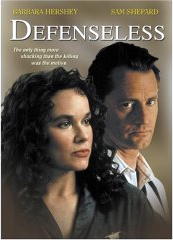
But this is Barbara Hershey’s film all the way. As attorney Thelma “T. K.” Knudsen Katwuller, she’s in (at an estimate) 90% of the movie’s footage, and if she weren’t watchable (but she is) there’d be no reason to watch at all. Her most striking feature in this movie is a large mane of unruly and terminally curly jet black hair, but as a character, it’s her disorganized and unlucky-in-love life that makes her sympathetic and vulnerable.
Brief story summary: She’s having an affair with her client (K. T. Walsh), a rich businessman who’s in trouble because a warehouse he owns has been used to make pornographic films. When she learns that he knows all about it, she goes ballistic. She’s also the one who calls the police when almost immediately after she finds him dead. As it happens, the dead man’s wife (Mary Beth Hurt, so blonde and southern it makes your teeth ache) was her college roommate 20 years earlier, and somewhat unaccountably she wants T. K. to represent her when she’s arrested for the crime.
As a homicide detective named Beutel, Sam Shepard is the only low-key player in the ensemble, so lanky and laconic you could picture him splitting rails in his spare time. There is a lot more I could tell you, but I’ve already told you more than I usually would, figuring some of the twists already mentioned should remain just that, twists. On the other hand, as I’ve already said, this is the barest bones of a rather complicated plot, and I’m holding back on all of the choicest parts.
I don’t know if I’ve got you leaning toward watching the movie or not, if by chance a copy happens along your way, but if you do – decide to watch, that is – you’re better off with the video rather the DVD version. There’s no warning on the label, but about 14 minutes are missing. The cuts remove the nude scenes, not surprisingly, but several other scenes are clipped as well, and others are completely eliminated. Also missing are crucial pieces of the plot, nicked to death here and there.
Mon 4 Feb 2008
JOHN FARRIS – Sacrifice. Tor; paperback reprint, June 1995. Hardcover edition: Tor, September 1994.
It has just occurred to me that John Farris has one of the longest careers of any mystery writer still active. His first novel, The Corpse Next Door, was published by Graphic Books, a small but solid line of mostly paperback originals, in 1956. Farris was born in 1936, so if the book wasn’t published until he was 20, the odds are the most of it was written when he was still nineteen.
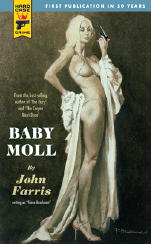
He switched to the pen name of Steve Brackeen for his next few books, typical Gold Medal thrillers, except that Gold Medal didn’t do them. One of them, Baby Moll (Crest, 1958), will be reprinted by Hard Case Crime later this year under his own name, a mere 50 years later.
Farris eventually became the author of the “Harrison High” books, which sold in the millions, and he became an even bigger seller once he started writing horror fiction that was invariably tinged with the supernatural. Books like The Fury (1976) and All Heads Turn When the Hunt Goes (1977) are as close to classics in the field as you’re going to get, and yet … even though Farris has averaged close to a book a year since those two books, unlike Stephen King, Dean R. Koontz and mystery-wise, Ed McBain, who came along about the same time he did, it is as if no one’s ever heard of him. Nobody knows his name.
(As a special note, back when Mystery*File was a print magazine, Bill Crider did a column on John Farris’s early career for me, and you can find it online here. You should go read it.)
Even though his later books veered convincingly away from standard mystery fare, there’s enough criminous element in them that most of them are included in Crime Fiction IV, Al Hubin’s bibliography of the field. Sacrifice is listed marginally, for example, but in Part 24 of the online Addenda to the Revised CFIV, the dash before the title has been removed.
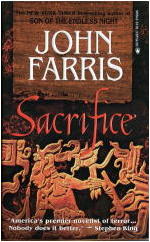
Rightfully so. One of the characters is C. G. Butterbaugh, a detective on the trail of the mysterious Greg Walker, who tells the first part of the story, and whose miraculous recovery from a gunshot wound to the head simply amazes the doctors on his case. When Walker and his daughter Sharissa then disappear into the mysterious interior of Guatemala from their sleepy town in Georgia, Butterbaugh needs all of his reading of Sherlock Holmes not to be shaken from the case.
Nor to be overwhelmed from what he discovers. Take the title of the story, Sacrifice; the fact that Sharissa, although a high school senior, is still a virgin; and the Guatemalan jungle – and what does that add up to you?
I won’t say, but every reviewer on Amazon will tell you, and as a matter of fact, so does Farris, long before this 379 page novel is halfway over. The question really is, how to we get to the ending from where we are, and who among the sizable cast of characters will survive?
I doubt that anyone could call this great literature, but once picked up, this is a book not easily put down. There might be something deeper going on, if you were analyze the all of the various relationships, many of them sexual in nature, that develop and entangle each other in this tale – the ending being particularly observant and poignant –
I’ll take that back. There’s no “might” about it. What this book demonstrates is why Farris has survived as a writer, and those who wrote most of the novels published during the horror boomlet in the 1980s and early 1990s have not. There’s some food for the mind in his fiction, at least this particular example, not just a slug to the gut.
Sat 2 Feb 2008
The artist for this nifty paperback cover isn’t identified, so I won’t hazard either a guess or an opinion, but if you believe you know, I’d surely like to hear from you.
That the girl looks something like Betty Grable, for those of us old enough to remember her, is not too surprising, as she starred in the 1941 film version with Victor Mature, Carole Landis, and Laird Cregar. I don’t believe I’ve ever seen the film, and now I’m itching to.
Frank Loose sent me the following publication data for the book, supplemented by my own records:
Hardcover:
Dodd, Mead & Co., 1941.
Robert Hale, UK, 1943.
Paperback:
Handi-Book #27, 1944.
Popular Library #129. No date stated. Frank says 1948; Graham Holroyd says 1947. Dealers on ABE seem to be 50-50 either way.
Bestseller Mystery B204, digest-sized, 1957.
Bantam Books A2145, 1960.
Black Lizard, 1988.
Vintage, 1991.
Frank also adds, “I have a copy of the Black Lizard, but I want to read the original. If I understand correctly, the revised version starts with the Bantam book in 1960. Everything before that date should be the original unedited, unrevised version.”
I’m sure Frank is right about this. I’m not sure, but I believe the reason for the revision is that Fisher himself wanted to “modernize” the book. If so, it’s the same thing John D. MacDonald did toward the end of his career when he published two collections of short stories taken from the 1940s pulp magazines. He rewrote some of the stories to make them seem as though they were taking place in the 1980s.
It was a really bad idea, as far as I was concerned — something like “colorizing” black-and-white movies.
But I don’t know for sure if that’s what Fisher did, nor why Black Lizard didn’t go back to the original novel for their edition. Once again, if you have more information, I hope you’ll pass it along.
From the back cover:
Once there was a girl named Vicky Lynn. She met Pegasus, a screen writer, and they fell in love. Then Pegasus and three friends pooled their resources to sponsor Vicky. They built her into a glamorous personality, and she won a screen contract. And the next day she was murdered.
For Pegasus, Vicky’s death was the end of the world, until he became aware of Vicky’s lovely sister Jill, who believed in him when everyone branded him killer.
To escape the police, Peg and Jill ran away, but their flight turned into a cycle of terror, of hiding and running from the ever-approaching shadow of a relentless, obsessed pursuer!
Sat 2 Feb 2008
What turned out to be unusual in this grouping of “A” authors taken from Part 23 of the online Addenda to the Revised Crime Fiction IV, is two incidental pairings of authors with the same name, two with the same year of birth.
ALFRED, WILLIAM. 1922-1999. Add as a new author entry. Longtime professor in medieval studies at Harvard University, specializing in early English literature.
-Hogan’s Goat. New York City: French, 1965. [Play.] Setting: New York City, 1890. TV movie: PBS, 1971 (scw: William Alfred; dir: Glenn Jordan). “A play in blank verse about the bitter political maneuvering among Irish-Americans in Brooklyn in the late 19th century.”
ALLINGTON, MAYNARD. 1931- . Career US Air Force officer, 1951-76, when he became a writer. Author of three wartime thrillers included in the (Revised) Crime Fiction IV. See below.
The Court of Blue Shadows. Washington: Brassey’s, hc, 1995. Updated setting: Europe, past. “A survivor of the Dachau concentration camp is haunted by his experiences […] as he searches for retribution.” [Reviewed in the New York Times.]
The Fox in the Field. Washington: Brassey’s, hc, 1994. Setting: India, World War II. “Derek Carr, a gambler and former arms smuggler blackmailed into working for British intelligence.”
The Grey Wolf. Warner, pb, 1986. [Corrected date.] Setting: Russia, World War II. “A thrilling tale of a British agent and his involvement in a military coup against Stalin, based on actual events in the USSR in 1942.”
ANDERSON, DON. 1931- . Add as a new author entry. BBC national and international television news reporter; left to form his own media, communications and web company in the 1990s.
Heatshield. Pan, UK, pb, 1990. Setting: Ireland, future. “On a secret mission in the Russian space shuttle, a cosmonaut is forced into a crash landing off the coast of Ireland.”
ANDERSON, DON. 1931- . [Note that though they share the same name and year of birth, this is not the same author as the one above.] Author of one novel included in the (Revised) Crime Fiction IV. See below.
The Price We Pay… Washington: Ye Galleon Press, hc, 1998. [Corrected spelling of publisher.] Setting: Seattle WA.
ANDERSON, LINDA. 1949- . Add as a new author entry. Member of the English Department of The Open University as Reader in Creative Writing, previously at Lancaster University.
-To Stay Alive. Bodley Head, UK, hc, 1984. Setting: Belfast, Northern Ireland. “Set in the bleak months before the 1979 Republican hunger strike in Long Kesh prison.” Short listed for the Higham and Sinclair Prizes.
ANDERSON, LINDA (née KIRCHMAN). [Noted here to distinguish her entry from that of the author above.] Add maiden name. Author of two romantic suspense novels included in the (Revised) Crime Fiction IV. See below.
The Secrets of Sadie Maynard. Pocket, pb, 1999. Setting: West Virginia. [Photojournalist Memphis Maynard returns to her West Virginia hometown to solve the 1936 murder of her grandmother, Sadie Maynard.]
When Night Falls. Pocket, pb, 2000. Setting: North Carolina. [Former prosecutor Lannie Sullivan in reclusion is stalked by a rapist recently released from jail.]
« Previous Page




